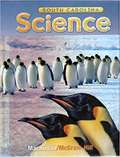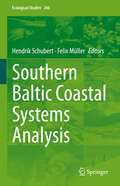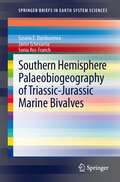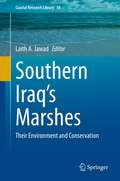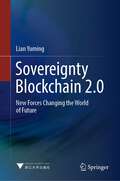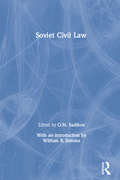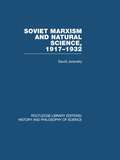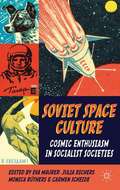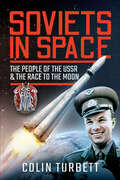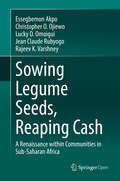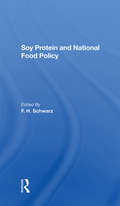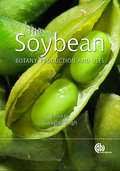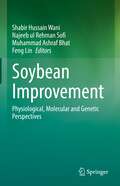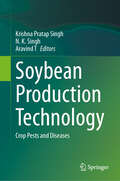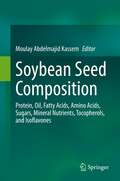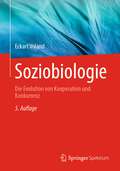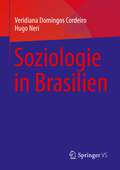- Table View
- List View
Southern Asia, Australia and the Search for Human Origins
by Robin Dennell Martin PorrThis is the first book to focus on the role of Southern Asia and Australia in our understanding of modern human origins and the expansion of Homo sapiens between East Africa and Australia before 30,000 years ago. With contributions from leading experts that take into account the latest archaeological evidence from India and Southeast Asia, this volume critically reviews current models of the timing and character of the spread of modern humans out of Africa. It also demonstrates that the evidence from Australasia should receive much wider and more serious consideration in its own right if we want to understand how our species achieved its global distribution. Critically examining the 'Out of Africa' model, this book emphasises the context and variability of the global evidence in the search for human origins.
Southern Baltic Coastal Systems Analysis (Ecological Studies Series #246)
by Felix Müller Hendrik Schubert<p>This book gives an overall analysis of the current knowledge status about structures, functions, utilization for German Baltic coast ecosystems. The main focus of this book is on the aquatic area, but land/sea interactions as well as river outfalls are included as well.<p> <p>Characteristic for this book is the inclusion of social science aspects. Approximately one third of its extent will be about the ecosystem services. In this segment the results of the last 6 years are presented in which a comprehensive quantification of the social relevance of ecosystems was carried out covering the entire area of the German Baltic Sea. This part builds directly on the results of scientific investigations and are in relation to social ideals. The assessment will not only be economically and ethically but also the mechanisms that are used for the valorisation of the ecosystem services will be evaluated.<p> <p>Both sub-areas, the classic natural science part as well as the part of social science aspects, deal with the changes caused by increasing anthropogenic influence and social (including demographic) changes. This will be among others in the sense of an exemplary historical outline.<p> <p>The final chapter of the synthesis therefore not only presents a summary of the level of knowledge gained and a deduction of the research needs. It further contains a presentation of the application aspects resulting from the analysis of the social relevance gained from basic scientific research.<p>
Southern Hemisphere Palaeobiogeography of Triassic-Jurassic Marine Bivalves
by Javier Echevarría Susana E. Damborenea Sonia Ros-FranchPalaeobiogeography is a complex subject which processes information provided by both Biology and Earth Sciences. It is conceptually and philosophically equivalent to neobiogeography. Nevertheless, its methods are somewhat different, since it is limited by the incompleteness of the fossil record. On the other hand, it has direct access to the time dimension, a key ingredient of organic evolution. Mesozoic benthonic mollusks, and especially bivalves, have a great potential for palaeobiogeographical analysis due to their commonly good preservation, abundance, diversity and high dispersion potential at the larval stage. From a merely descriptive point of view, the analysis of their distribution shows latitudinal gradients and distributional patterns, both at regional and global scales, which are the basis for the recognition of biochoremas or palaeobiogeographical units of different ranks. Moving forward towards a causal palaeobiogeography, these organisms also provide interesting insight into particular biogeographical questions, such as bipolarity and its origin. The evolution in time of the recognized biochoremas can be discussed in relation to palaeoclimas and extinction events. Finally, some of the results obtained from the analysis of the distribution of past bivalve biotas were even used to propose and discuss the development of marine corridors and argue about the distribution of continents in the past.
Southern Iraq's Marshes: Their Environment and Conservation (Coastal Research Library #36)
by Laith A. JawadThe Mesopotamian marshes are important for economic, social, and biodiversity values and have been home to indigenous human communities for millennia. They are regarded as a legendary site. This multi-authored book contains chapters written by world-renowned experts in their field. Both basic and applied information are made available, making the book a must-have for a wide spectrum of users. For example, an understanding of the natural and the social aspects of the marshes, as described here, is an obvious prerequisite for a pest management plan in this area. Scholars interested in wetlands can use this book as a guide to compare different wetlands areas in Asia. The bibliography section contains valuable references to the marsh areas and research in the field. This book serves as an up-to-date comprehensive source of information on different aspects of the southern marshes of Iraq and is aimed at academic scholars, environmentalists, and decision makers.
Sovereignty Blockchain 2.0: New Forces Changing the World of Future
by Lian YumingThis book is a continuation and deepening of Sovereign Blockchain 1.0. It mainly includes three views: 1) Blockchain is a super public product based on digital civilization. 2) The Internet is an advanced level of industrial civilization, the core of which is connection; blockchain is an important symbol of digital civilization, the essence of which is reconstruction. 3) Digital currency will trigger a comprehensive change in the economic field, and digital identity will reconstruct the governance model in the social field, thereby changing the order of civilization.This book is not only a popular science book based on blockchain thinking, theory and application research, but also a scholarly work on the technical and philosophical issues of governance and the future. By reading Sovereign Blockchain 2.0, policymakers can quickly understand the basic knowledge and frontier dynamics of science and technology; science and technology workers can grasp the general trend, seize opportunities, face problems and difficulties, aim at the world's science and technology frontier and lead the direction of science and technology development; experts and scholars in law and legal fields can see new ideas, concepts and models of data governance; social science researchers can discover data sociology and data philosophy issues.
Soviet Civil Law
by O.N. SadikovThis volume is an unabridged translation of the textbook ‘Soviet Civil Law’, originally published in 1983 under the auspices of the USSR Ministry of Justice. Edited by Professor O.N. Sadikov, the work includes contributions from nine Soviet legal scholars
Soviet Marxism and Natural Science: 1917-1932 (Routledge Library Editions: History & Philosophy of Science)
by David JoravskyOriginally published in 1961. Russian Marxist philosophy of science originated among men and women who gave their whole lives to rebellion against established authority. The original tension within Marxist philosophy between positivism and metaphysics was repressed but not resolved in this first phase of Soviet Marxism. In this volume the author correlates the development of ideas with trends in the Cultural Revolution and against this background it is possible to understand why debates over general philosophy gave way to conflicts over specific sciences in the aftermath of the first Five Year Plan and why there was a genuine crisis in Soviet biology.
Soviet Space Culture
by Eva Maurer Julia Richers Monica Ręthers Carmen ScheideStarting with the first man-made satellite 'Sputnik' in 1957 and culminating four years later with the first human in space, Yuri Gagarin, space became a new utopian horizon. This book explores the profound repercussions of the Soviet space exploration program on culture and everyday life in Eastern Europe, especially in the Soviet Union itself.
Soviets in Space: The People of the USSR & the Race to the Moon
by Colin TurbettThe victory over Nazi Germany in 1945, in which the Soviet Union played both the greatest part and suffered the greatest losses, found the country in a state of devastation. Military strength could not compensate for the damage wreaked by war, especially in the western areas of the USSR. Within just over ten years, not only was Stalin dead and the relative freedoms of the Khrushchev 'Thaw' in progress, but the Soviet Union was ahead in the Space Race – beating the enormous wealth and resources of the USA, launching Soviet citizens from ordinary backgrounds quite literally into worlds beyond our own. The communist dream seemed alive and well. The story of those years has rarely been told from a Soviet perspective: Cold War journalism and historical accounts written in the West tend to portray the space race in terms of ideological competition - with success and failure mirroring power and influence in a world divided between capitalism and communism. Whilst the military on both sides certainly benefited from the cutting edge technological advance of the space programmes, for the people of the USSR the prestige of their successes offered proof that 'real existing socialism' was moving mankind onto new levels of peaceful progress. Agriculture and railway building initiatives tried to involved ordinary people in other pioneering projects to build socialism before the dream shattered in the 1980s. Extensively illustrated with images from the time, this book looks at the years of Soviet space success, their background, the personalities involved, and their impact on the ordinary people of the USSR.
Sowing Legume Seeds, Reaping Cash: A Renaissance within Communities in Sub-Saharan Africa
by Rajeev K. Varshney Essegbemon Akpo Christopher O. Ojiewo Lucky O. Omoigui Jean Claude RubyogoThis open access book shares impact stories – testimonies from various value chain actors who have been part of the Tropical Legumes (TL) projects, over the past twelve years. The Tropical Legumes projects led by ICRISAT in three parts (TLI, TLII and TLIII), constitute a major international initiative supported by the Bill & Melinda Gates Foundation (BMGF) and jointly implemented by the International Center for Tropical Agriculture (CIAT), International Institute of Tropical Agriculture (IITA) and National Agricultural Research Systems (NARS) partners from Sub-Saharan Africa and India. The project developed improved cultivars of common bean, cowpea, chickpea and groundnut (but also soya bean and pigeon pea cultivars in its initial phases) and delivers their seed to smallholders in BMGF-focus areas. It also strengthens the NARS and CGIAR's breeding programs and seed platforms to enhance their ability to deliver high and sustained outputs to smallholder farmers. The book compiles the experiences of a diversity of actors within the grain legume value chains, with a focus on groundnut and common beans in Tanzania and Uganda, groundnut and cowpea in Nigeria, and groundnut in Ghana. All stakeholders involved share their thoughts on being part of a decade-long development project family. National agricultural research institutes, knowledge brokering organizations, NGOs, public and private seed companies, agro-dealers, individual seed entrepreneurs, farm-implement makers, farmer cooperatives, farmer groups, individual men and women farmers, middlemen, processors, traders and consumers were all involved in this project, and as such this book provides valuable insights for development workers, technical staff, and project managers.
Soy Protein And National Food Policy
by F. H. Schwarz Marshall Marcus F J SchwarzOver the last twenty-five years, a healthy international business has developed in isolated soy protein food ingredients. Today, isolated soy proteins are used primarily as ingredients in processed meat products. They are also used as valuable sources of protein in medical nutritional products and in combination with dairy products around the world
Soybean
by Guriqbal Singh David Mcneil Nawab Ali Dilip Panthee Rita Raghuvanshi Glen Hartman Prabal Ghosh Digvir Jayas Edward Oyekanmi G. Chauhan Saratha Kumudini Vineet Kumer Anita Rani A. Rao Matthew O'Neal Dennis Egli S. Shanmusgasundaram Lijuan Qiu J. Mishra Jonas ChianuThe soybean is a crop of global importance and is one of most frequently cultivated crops worldwide. It is rich in oil and protein, used for human and animal consumption as well as for industrial purposes. Soybean plants also play an important role in crop diversification and benefit the growth of other crops, adding nitrogen to the soil during crop rotation. With contributions from eminent researchers from around the world, The Soybean provides a concise coverage of all aspects of this important crop, including genetics and physiology, varietal improvement, production and protection technology, utilization and nutritional value.
Soybean Improvement: Physiological, Molecular and Genetic Perspectives
by Shabir Hussain Wani Feng Lin Najeeb ul Rehman Sofi Muhammad Ashraf BhatSoybean (Glycine max L. (Merr)) is one of the most important crops worldwide. Soybean seeds are vital for both protein meal and vegetable oil. Soybean was domesticated in China, and since last 4-5 decades it has become one of the most widely grown crops around the globe. The crop is grown on an anticipated 6% of the world’s arable land, and since the 1970s, the area in soybean production has the highest percentage increase compared to any other major crop. It is a major crop in the United States, Brazil, China and Argentina and important in many other countries. The cultivated soybean has one wild annual relative, G. soja, and 23 wild perennial relatives. Soybean has spread to many Asian countries two to three thousand years ago, but was not known in the West until the 18th century. Among the various constraints responsible for decrease in soybean yields are the biotic and abiotic stresses which have recently increased as a result of changing climatic scenarios at global level. A lot of work has been done for cultivar development and germplasm enhancement through conventional plant breeding. This has resulted in development of numerous high yielding and climate resilient soybean varieties. Despite of this development, plant breeding is long-term by nature, resource dependent and climate dependent. Due to the advancement in genomics and phenomics, significant insights have been gained in the identification of genes for yield improvement, tolerance to biotic and abiotic stress and increased quality parameters in soybean. Molecular breeding has become routine and with the advent of next generation sequencing technologies resulting in SNP based molecular markers, soybean improvement has taken a new dimension and resulted in mapping of genes for various traits that include disease resistance, insect resistance, high oil content and improved yield.This book includes chapters from renowned potential soybean scientists to discuss the latest updates on soybean molecular and genetic perspectives to elucidate the complex mechanisms to develop biotic and abiotic stress resilience in soybean. Recent studies on the improvement of oil quality and yield in soybean have also been incorporated.
Soybean Production Technology: Crop Pests and Diseases
by N. K. Singh Krishna Pratap Singh Aravind TThis book is dealing with the crop protection in soybean covering all the major insects’ pests, diseases and weeds infesting soybean. The main focus of the book is to provide a single point comprehensive reference on the pests and diseases in soybean covering all the latest advancements in the field. The book covers the taxonomic status, symptomatology, morphology, epidemiology and management of all the major pests and diseases in soybean. Special attention is given to different components of integrated pest management and the latest biotechnological interventions in the field. The pests and diseases are a major constraint in the soybean cultivation leading to significant yield losses. Meticulous understanding on these pests is critical for the accurate identification and adoption of the effective management strategies against them. This play a crucial role in enhancing the soybean production and thereby help in meeting the globally increasing demand for vegetable oil and protein. The book is of special interest to academicians, professionals and policy makers actively associated with the research on crop protection in soybean and a valuable source of reference to students, scientists, industrialists and farmers working on soybean.
Soybean Production Technology: Physiology, Production and Processing
by N. K. Singh Krishna Pratap Singh Aravind TThis contributed volume offers a comprehensive overview of the physiology, production, and processing of soybean, focusing on the latest advancements in soybean production technology. It covers recent innovations in the field, providing essential information on geographic distribution, uses, physiology, crop improvement, and processing of soybean. Soybean is a globally significant oilseed and legume crop, vital in meeting the rising global demand for vegetable oil and protein. Updated knowledge on key topics related to soybean production is crucial for adopting sustainable crop production strategies. This includes integrating indigenous knowledge with the latest cost-effective and efficient technological interventions. The book is of particular interest to academicians, professionals, and policymakers involved in soybean research and development. It also serves as a valuable reference for students, scientists, industrialists, and farmers working on various aspects of soybean.
Soybean Seed Composition: Protein, Oil, Fatty Acids, Amino Acids, Sugars, Mineral Nutrients, Tocopherols, and Isoflavones
by Moulay Abdelmajid KassemSoybean Seed Composition covers three decades of advances in quantitative trait loci (QTL) mapping of seed protein, oil, fatty acids, amino acids, sugars, mineral nutrients, isoflavones, lunasin, and other beneficial compounds. It opens with coverage of seed protein, oil, fatty acids, and amino acids and the effects that genetic and environmental factors have on them. Detailed discussion of QTL that control seed protein, oil, and fatty acids follows, and the book also covers seed amino acids, macronutrients, micronutrients, sugars, and other compounds that are key to selection for crop improvement. The book also provides an overview of two decades of QTL mapping of mineral deficiencies in soybean, which sheds light on the importance of a balanced mineral nutrition in soybean and other crops, elucidates salt stress tolerance QTL mapping, which is another challenge that faces soybean and other crop production worldwide. The importance of soybean seed isoflavones from their biosynthesis and quantification methods to locations and variations in seeds, roots, and leaves, to their QTL mapping is discussed, as well as providing key information on lunasin, a bioactive anticancer peptide in soybean seeds that will help farmers and breeders to develop soybean cultivars with improved seed isoflavones and lunasin content. The book will be of interest to graduate students, academics, and researchers in the fields of genetic and QTL mapping of important agronomic traits in soybean and other crops.
Sozial - Innovativ - Nachhaltig: Herausforderungen und Perspektiven für die Sozialwirtschaft (Perspektiven Sozialwirtschaft und Sozialmanagement)
by Birgit Schmidtke Daniela Molzbichler Martin Lu KolbingerDer Tagungsband zum 8. Fachkongress der Internationalen Arbeitsgemeinschaft Sozialmanagement / Sozialwirtschaft (INAS) an der FH Salzburg thematisiert aus sozialwissenschaftlicher Perspektive innovative, soziale und nachhaltige Ansätze der Sozialwirtschaft, um auf aktuelle gesellschaftliche Problemlagen zu reagieren und zukünftige Herausforderungen zu bewältigen. Die hier zusammengeführte sozialwissenschaftliche Expertise ermöglicht ein besseres Verständnis für die Bedingungen, Methoden und Wirkungen sozialer und nachhaltiger Innovationen.
Soziale Netzwerke – Die Familie von heute: Recht und Politik der Regulierung
by Vanessa KirchSoziale Netzwerke haben eine Fülle von Problemen in Bezug auf die Privatsphäre und den Schutz personenbezogener Daten aufgeworfen. Die Nutzung sozialer Netzwerke ist zu einem zentralen Anliegen von Rechtswissenschaftlern, politischen Entscheidungsträgern und den Betreibern sowie den Nutzern dieser sozialen Netzwerke geworden. Dieses bahnbrechende Buch beleuchtet die Bedeutung des Datenschutzes im Zusammenhang mit den neuen elektronischen Kommunikationstechnologien von heute, da es widersprüchliche Ansprüche zum Schutz der nationalen und internationalen Sicherheit, der Freiheit des Internets und wirtschaftlicher Überlegungen aufzeigt. Auf der Grundlage des intellektuellen Rahmens der New Haven School of Jurisprudence stellt der Autor das geltende Recht zum Schutz der Privatsphäre und zu sozialen Medien in internationaler und vergleichender Perspektive dar und konzentriert sich dabei auf die Vereinigten Staaten, die Europäische Union und ihre Allgemeine Datenschutzverordnung von 2018 sowie auf Deutschland, das Vereinigte Königreich und Lateinamerika. Das Buch bewertet das geltende Recht, erörtert Alternativen und gibt Empfehlungen für eine öffentliche Ordnung der Menschenwürde. Übersetzt mit www.DeepL.com/Translator (kostenlose Version)
Soziobiologie: Die Evolution von Kooperation und Konkurrenz
by Eckart VolandSoziobiologie ist den evolutionsbiologischen Ursprüngen und Gründen tierlichen und menschlichen Sozialverhaltens auf der Spur. In diesem Buch werden Strategien sozialer Konkurrenz, also Gewalt, Kampf und Dominanz behandelt, aber auch Kooperation, Altruismus und Solidarität. Die Interessen der beiden Geschlechtern sind Treibstoff der sexuellen Selektion. Kooperation ist also immer auch brüchiger Kompromiss im Kampf der Geschlechter zu verstehen. Außerdem geht es um die neuesten Erkenntnisse zur Evolution der Eltern/Kind-Verhältnisses und um ein Brutpflegeverhalten, das Kindesvernachlässigung und zugleich auch tief empfundene elterliche Zuneigung und Fürsorge möglich macht. Beschrieben wird, wie eine evolutionäre Perspektive auf das menschliche Verhalten zum modernen Menschenbild beiträgt. Das Buch richtet sich an Studierende und Lehrende der Biologie, Anthropologie, Psychologie und Sozialwissenschaften und an alle an der evolutionären Geschichte des menschlichen Sozialverhaltens Interessierte.
Soziologie in Brasilien
by Veridiana Domingos Cordeiro Hugo NeriDieses Buch gibt einen Überblick über die institutionelle und intellektuelle Entwicklung der Soziologie in Brasilien von den frühen 1900er Jahren bis heute, über Militärputsche, Diktaturen und Demokratien hinweg. Es zeichnet den tiefgreifenden Einfluss der Soziologie auf das öffentliche Leben Brasiliens nach und zeigt, wie sich die Umwälzungen in der Geschichte des Landes und seiner Universitäten auf die wissenschaftliche Agenda ausgewirkt haben. Diese fesselnde Darstellung verdeutlicht das Ausmaß des kolonialen Erbes der Disziplin, ihre frühe Institutionalisierung in São Paulo und ihren kongruenten Aufstieg und Fall während wiederholter Regimewechsel. Die Analyse der Autoren stützt sich auf Originaluntersuchungen, die die Konzentration von Forschungsinteressen, neuen Entwicklungen, Publikationen und Produktionszentren in der brasilianischen Soziologie anhand qualitativer und quantitativer Daten kartieren. Das Buch schließt mit einer Reflexion über die möglichen Auswirkungen der jüngsten rechtsextremen Wende in der brasilianischen Politik auf die Zukunft der Disziplin. Es leistet einen wertvollen Beitrag zur Geschichte der Soziologie und richtet sich an Sozialwissenschaftler sowie an Wissenschaftler, die sich mit disziplinärer Geschichtsschreibung, Geistesgeschichte und brasilianischer Geschichte befassen.

